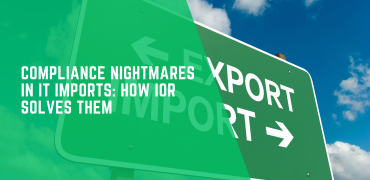In the fast-evolving world of global trade, making informed import decisions is critical for businesses striving to optimize costs, improve supply chain efficiency, and maintain compliance with regulations. Traditional methods of decision-making often rely on historical trends and manual assessments, which can be time-consuming and prone to error. However, with the advent of data analytics, companies can leverage real-time insights to make smarter import decisions. One of the key facilitators in this process is the Importer of Record (IOR), whose role is significantly enhanced when paired with data analytics.
This blog explores how data analytics can revolutionize import decisions and the advantages of integrating these insights with the IOR framework.
The Role of Data Analytics in Import Decisions
Data analytics encompasses a variety of techniques and tools used to analyze raw data and extract meaningful insights. In the context of international trade, it enables businesses to:
1. Improve Cost Efficiency
By analyzing historical shipment data, businesses can identify cost-saving opportunities such as alternative suppliers, optimized shipping routes, and reduced tariffs. Predictive analytics can forecast future price trends, helping businesses make proactive purchasing decisions.
2. Enhance Supply Chain Visibility
Data analytics enables real-time tracking of shipments, monitoring of delivery schedules, and identification of potential delays. This visibility helps businesses adjust logistics strategies in real-time, ensuring a smooth supply chain.
3. Ensure Regulatory Compliance
Different countries have varying import regulations, duties, and restrictions. Data analytics helps businesses stay compliant by automatically analyzing trade laws and highlighting potential compliance risks. Machine learning algorithms can further predict possible regulatory changes and their impact.
4. Optimize Inventory Management
By leveraging historical demand patterns and real-time sales data, companies can predict inventory requirements accurately. This prevents stockouts and overstocking, reducing unnecessary warehousing costs and improving overall efficiency.
5. Reduce Fraud and Errors
Manual data entry and paperwork often lead to errors and fraudulent activities. Data analytics minimizes such risks by automating document verification, detecting anomalies in transactions, and flagging potential fraudulent activities before they become costly mistakes.
The IOR Advantage in Data-Driven Import Strategies
An Importer of Record (IOR) is responsible for ensuring that goods meet all import requirements, including documentation, tax payments, and regulatory compliance. Traditionally, IORs have played a reactive role, ensuring compliance after goods are shipped. However, integrating data analytics into IOR functions provides several strategic advantages:
1. Proactive Risk Management
IORs using data analytics can assess potential risks before shipments leave their origin. By analyzing past compliance issues, customs rejections, and regulatory updates, businesses can avoid costly delays and penalties.
2. Streamlined Documentation Processes
Data analytics automates documentation management, reducing paperwork errors and speeding up customs clearance. Automated data validation ensures that all required documents, such as commercial invoices, certificates of origin, and import licenses, are accurate and complete.
3. Improved Tariff Classification and Cost Reduction
Harmonized System (HS) codes determine the duties imposed on imported goods. Misclassification can lead to higher costs or penalties. AI-powered analytics tools help classify products accurately, ensuring compliance and optimizing duty payments.
4. Real-Time Regulatory Updates
Trade regulations are dynamic and subject to frequent changes. IORs using analytics can monitor and integrate real-time updates, allowing businesses to adapt quickly and maintain compliance effortlessly.
5. Optimized Import Routes and Logistics
By analyzing customs processing times, shipping lane congestion, and past performance of logistics providers, data analytics can recommend the most efficient and cost-effective import routes.
Implementing Data Analytics in Import Decision-Making
For businesses looking to integrate data analytics into their import strategies, the following steps are essential:
1. Invest in Advanced Analytics Tools
Companies should leverage AI-powered platforms that offer predictive analytics, machine learning, and real-time data processing to gain actionable insights.
2. Develop a Data-Driven Culture
Encouraging employees to rely on data for decision-making ensures more accurate and efficient operations. Training and workshops can help build data literacy within an organization.
3. Collaborate with Data-Savvy IORs
Partnering with IORs that utilize data analytics ensures compliance, cost savings, and risk mitigation through informed decision-making.
4. Leverage IoT and Blockchain for Transparency
IoT-enabled tracking devices and blockchain technology enhance data accuracy, providing end-to-end visibility and security in import processes.
5. Regularly Monitor and Update Data Strategies
As technology and regulations evolve, businesses must continuously refine their data analytics approach to stay ahead of industry trends.
Conclusion
The integration of data analytics in import decision-making presents a transformative opportunity for businesses engaged in global trade. From cost efficiency and compliance to risk management and optimized logistics, leveraging data-driven insights allows for smarter, more strategic import operations.
Furthermore, the role of an Importer of Record (IOR) is no longer just about compliance but has evolved into a data-driven function that enhances supply chain efficiency. Companies that embrace this shift and invest in analytics-driven import strategies will gain a competitive advantage, ensuring seamless international trade operations and sustained profitability.
By combining the power of data analytics with the expertise of an IOR, businesses can future-proof their import operations and navigate the complexities of global trade with confidence.




